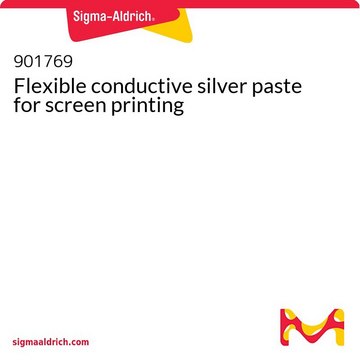907669
Silver ink
75 wt%, LIFT printable
Sinónimos:
Ag ink, Laser induced forward transfer
About This Item
Productos recomendados
description
Silver content : 75 wt%
Solvent : Diethylene Glycol Mono Butyl Ether (DGBE)
Surface Tension : 28 dyn/cm (Pendant Drop)
form
paste
particle size
50-70 nm (by Lumisizer™)
90-120 nm (by Lumisizer™)
viscosity
50,000-100,000 cP (Shear Rate: 1 s-1
250cP - 450 cP (Shear Rate: 1000 s-1))
density
2.85-3.3
storage temp.
15-25°C
Categorías relacionadas
Application
The ink offers:
- Uniform and reproducible donor layer with low drying speed
- Stable accurate jetting in different types of laser systems, wide working window of jetting parameters
- High speed printing (20-50kHz), allowing high throughput
- Narrow patterning on plastic and glass substrates (line width ∼50 μm, height ∼0.5 μm, spacing ∼50 μm)
- Laser sintering of LIFT printed pattern, providing good electrical properties
Fit for:
LIFT digital printing
Additive electronic manufacturing
Printed electronics: RFID, FPD, Sensors
Laser induced forward transfer printing (LIFT) is a non-contact, nozzle-free, one step, direct laser writing process.
LIFT can operate under atmospheric conditions, is compatible with low laser fluences, allows the printing of organic and inorganic materials as well as biological elements. The printing process can take place from both liquid and solid phases. It further has a high lateral resolution only defined by the laser spot size. It is a method compatible with inorganic semiconductor sensor fabrication, OLED fabrication and bio printing.
Other Notes
*Parameters should be optimized depending on line geometry and substrate
Storage and Stability
Legal Information
signalword
Warning
hcodes
Hazard Classifications
Aquatic Acute 1 - Aquatic Chronic 1 - Eye Irrit. 2
Storage Class
10 - Combustible liquids
wgk_germany
WGK 3
flash_point_f
Not applicable
flash_point_c
Not applicable
Elija entre una de las versiones más recientes:
Certificados de análisis (COA)
¿No ve la versión correcta?
Si necesita una versión concreta, puede buscar un certificado específico por el número de lote.
¿Ya tiene este producto?
Encuentre la documentación para los productos que ha comprado recientemente en la Biblioteca de documentos.
Los clientes también vieron
Artículos
Professor Tokito and Professor Takeda share their new materials, device architecture design principles, and performance optimization protocols for printed and solution-processed, low-cost, highly flexible, organic electronic devices.
Nuestro equipo de científicos tiene experiencia en todas las áreas de investigación: Ciencias de la vida, Ciencia de los materiales, Síntesis química, Cromatografía, Analítica y muchas otras.
Póngase en contacto con el Servicio técnico










